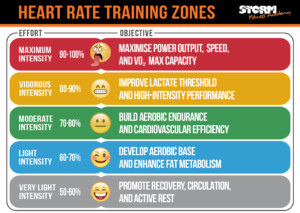GET IN TOUCH TODAY!
"*" indicates required fields

Whether you’re designing fat-burning sessions, building stamina, or pushing clients to peak intensity, heart rate training zone models offer a structured, science-backed way to tailor workouts for results. In this blog, we break down the most widely used zone models, how they relate to energy systems, and how PTs can use them to develop both aerobic and anaerobic capacity.
Heart rate training zones are intensity bands based on a percentage of an individual’s maximum heart rate (HRmax). Each zone targets a different physiological adaptation—some improving fat metabolism and endurance, others developing speed, power, and recovery efficiency.
Most models divide heart rate into five or six zones, based on estimated HRmax (commonly calculated as 220 minus age). Advanced methods use lactate threshold testing or heart rate reserve (HRR) for greater accuracy, but for general fitness clients, the basic models still offer real value.

This is one of the most commonly used models in personal training and endurance coaching:
Focus: Recovery, warm-ups, cool-downs
Fuel Source: Predominantly fat
Use: Low-intensity movement for deconditioned clients or active recovery sessions
Focus: Building aerobic endurance and fat metabolism
Fuel Source: Fat with increased mitochondrial efficiency
Use: Long steady-state cardio sessions; foundational for beginners and endurance athletes
Focus: Cardiovascular fitness and stamina
Fuel Source: Combination of fat and carbohydrates
Use: Moderate-intensity sessions—cycling, jogging, long circuits
Focus: Lactate threshold training
Fuel Source: Primarily carbohydrates (glycolysis)
Use: Intervals, tempo runs, or circuits that challenge anaerobic capacity
Focus: Peak anaerobic power and VO₂max
Fuel Source: Carbohydrates, phosphagen system
Use: Sprint intervals, HIIT, explosive training blocks
Aerobic capacity refers to your client’s ability to perform sustained exercise over time. Training in Zones 2 and 3 helps improve:
Mitochondrial density
Capillary networks in muscles
Stroke volume and cardiac output
Fat utilisation efficiency
Over time, this makes clients more efficient at using oxygen, reducing fatigue, and recovering quicker between efforts.
Anaerobic capacity focuses on high-intensity efforts that exceed the body’s ability to supply oxygen fast enough—relying on glycogen stores instead. Zones 4 and 5 are crucial for:
Improving tolerance to lactate accumulation
Increasing power and speed
Enhancing muscle buffering capacity
This type of training is ideal for athletes or advanced clients who need explosive performance and rapid recovery between intervals.
Zone-based training can be structured using periodisation, cycling through blocks that build aerobic capacity first (Zones 1–3), then layering anaerobic training (Zones 4–5). This approach allows for progressive overload and adaptation while managing fatigue and injury risk.
Calculate HRmax accurately using client-specific data or tests when possible.
Educate clients on the “feel” of each zone using RPE scales or the Talk Test to aid compliance.
Use wearable tech to monitor real-time HR and gather session data for review.
Include progress testing every 6–8 weeks to reassess and adapt zones.
❌ Guessing intensity without heart rate data
❌ Skipping aerobic base work and jumping straight into HIIT
❌ Neglecting recovery zones which aid adaptation and reduce injury
❌ Using one-size-fits-all HR zones for every client
By understanding and applying heart rate zone models, personal trainers can write more personalised, effective training plans. Whether your client wants fat loss, a faster 5K, or improved performance on the pitch, zone-based training allows you to match the right intensity to the right goal—backed by physiology, not guesswork.
Storm Fitness Academy offers Level 3 and Level 4 qualifications that break this down in depth, with real-world strategies you can apply immediately.
Explore our courses or get in touch for a friendly chat about how to become a better coach.
"*" indicates required fields